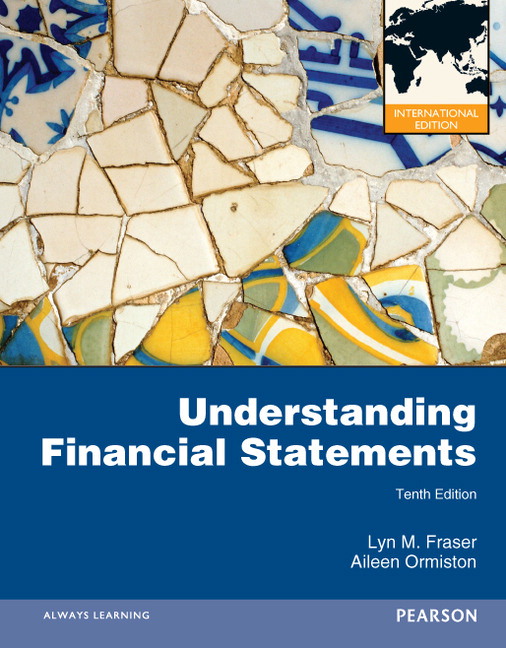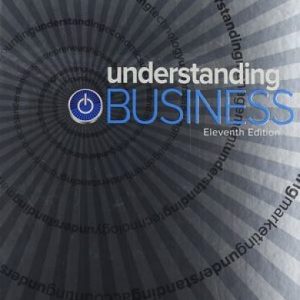Solution Manual for Understanding Financial Statements: International Edition, 10/E Aileen Ormiston, Lyn M. Fraser digital download immediately after payment is complete.

Product details:
- ISBN-10 : 0132655063
- ISBN-13 : 978-0132655064
- Author: Fraser and Ormiston
Fraser and Ormiston take readers behind the financial reports to assess the real financial condition and performance of U.S. companies.
Understanding Financial Statements retains its reputation for readability, concise coverage, and accessibility, and gives readers the conceptual background and analytical tools necessary to understand and interpret business financial statements. Its ultimate goal is to improve readers’ ability to translate financial statement numbers into a meaningful map for business decisions and enable each reader to approach financial statements with enhanced confidence.
Table contents:
- Chapter 1 Financial StatementsAn Overview
- Map or Maze
- Usefulness
- Volume of Information
- Where to Find a Company’s Financial Statements
- The Financial Statements
- Notes to the Financial Statements
- Auditor’s Report
- Financial Reporting Reforms
- Management Discussion and Analysis
- Five-Year Summary of Selected Financial Data and Market Data
- Pandora (a.k.a. “PR Fluff”)
- Proxy Statement
- Missing and Hard-to-Find Information
- Complexities
- Accounting Choices
- The Future of Financial Statements
- Quality of Financial Reporting
- Timing of Revenue and Expense Recognition
- Discretionary Items
- The Journey Through the Maze Continues
- Self-Test
- Study Questions and Problems
- Cases
- Case 1.1 Intel Case
- Case 1.2 Avnet Comprehensive Analysis Case Using the Financial Statement Analysis Template
- Case 1.3 Mattel Inc.
- Required
- Case 1.4 Apple Inc.
- Required
- Executive Overview
- Fiscal Year 2010 versus 2009
- Fiscal Year 2009 versus 2008
- Segment Operating Performance
- Retail
- Gross Margin
- Operating Expenses
- Research and Development Expense (“R&D”)
- Selling, General and Administrative Expense (“SG&A”)
- Other Income and Expense
- Provision for Income Taxes
- Liquidity and Capital Resources
- Capital Assets
- Chapter 2 The Balance Sheet
- Financial Condition
- Consolidation
- Balance Sheet Date
- Comparative Data
- Common-Size Balance Sheet
- Assets
- Current Assets
- Cash and Cash Equivalents
- Marketable Securities
- Accounts Receivable
- Inventories
- Inventory Accounting Methods
- Prepaid Expenses
- Property, Plant, and Equipment
- Straight line
- Accelerated5
- Goodwill
- Other Assets
- Liabilities
- Current Liabilities
- Accounts Payable
- Short-Term Debt
- Current Maturities of Long-Term Debt
- Accrued Liabilities
- Unearned Revenue or Deferred Credits
- Deferred Federal Income Taxes
- Long-Term Debt
- Capital Lease Obligations
- Pensions and Postretirement Benefits
- Commitments and Contingencies
- Stockholders’ Equity
- Common Stock
- Additional Paid-In Capital
- Retained Earnings
- Other Equity Accounts
- Quality of Financial Reporting—The Balance Sheet
- Other Balance Sheet Items
- Self-Test
- Study Questions and Problems
- Cases
- Case 2.1 Intel Case
- Case 2.2 Avnet Comprehensive Analysis Case Using the Financial Statement Analysis Template
- Case 2.3 Logitech International S.A.
- Logitech International S.A. Notes to Consolidated Financial Statements
- Note 1—The Company
- Note 2—Summary of Significant Accounting Policies
- Concentration of Credit Risk
- Allowances for Doubtful Accounts
- Inventories
- Note 7—Balance Sheet Components
- Note 8—Goodwill and Other Intangible Assets
- Note 9—Financing Arrangements
- Note 16—Commitments and Contingencies
- Required:
- Case 2.4 Walgreen Co. and Subsidiaries
- Notes to Consolidated Financial Statements
- Required:
- Chapter 3 Income Statement and Statement of Stockholders’ Equity
- The Income Statement
- Common-Size Income Statement
- Net Sales
- Cost of Goods Sold
- Gross Profit
- Operating Expense
- Operating Profit
- Other Income (Expense)
- Equity Earnings
- Earnings Before Income Taxes/Effective Tax Rate
- Special Items
- Net Earnings
- Earnings per Common Share
- Comprehensive Income
- The Statement of Stockholders’ Equity
- Earnings Quality, Cash Flow, and Segmental Accounting
- Self-Test
- Study Questions and Problems
- Cases
- Case 3.1 Intel Case
- Case 3.2 Avnet Comprehensive Analysis Case Using the Financial Statement Analysis Template
- Case 3.3 Taser International Inc.
- Item 1. Business Overview
- Results of Operations
- Sales, General and Administrative Expenses
- Research and Development Expenses
- Required:
- Case 3.4 Zebra Technologies Corporation
- Item 1. Business The Company
- Note 7 Goodwill and Other Intangible Asset Data
- Note 17 Income Taxes
- Required:
- Chapter 4 Statement of Cash Flows
- Why Cash Flow Is Important: An Example
- Statement of Cash Flows: Basic Principle
- Preparing a Statement of Cash Flows
- Calculating Cash Flow from Operating Activities
- Indirect Method
- Cash Flow from Investing Activities
- Cash Flow from Financing Activities
- Change in Cash
- Analyzing the Statement of Cash Flows
- Cash Flow from Operations
- Nocash Corporation
- Sage Inc.: Analysis of the Statement of Cash Flows
- Sage Inc. Analysis: Cash Flow from Operating Activities
- Summary Analysis of the Statement of Cash Flows
- Analysis of Cash Inflows
- Analysis of Cash Outflows
- Qualitative Issues Relating to the Statement of Cash Flows
- Are We There Yet?
- Self-Test
- Study Questions and Problems
- Cases
- Case 4.1 Intel Case
- Case 4.2 Avnet Comprehensive Analysis Case Using the Financial Statement Analysis Template
- Case 4.3 Gerber Scientific Inc.
- Required:
- Case 4.4 Agilysys Inc.
- Item 1. Business
- Overview
- Note 8. Financing Arrangements
- IBM Floor Plan Agreement
- Required:
- Chapter 5 The Analysis of Financial Statements
- Objectives of Analysis
- Sources of Information
- Proxy Statement
- Auditor’s Report
- Management Discussion and Analysis
- Supplementary Schedules
- Form 10-K and Form 10-Q
- Other Sources
- Tools and Techniques
- Common-Size Financial Statements
- Key Financial Ratios
- Liquidity Ratios: Short-Term Solvency
- Cash Conversion Cycle or Net Trade Cycle
- Activity Ratios: Asset Liquidity, Asset Management Efficiency
- Leverage Ratios: Debt Financing and Coverage
- Profitability Ratios: Overall Efficiency and Performance
- Market Ratios
- Analyzing the Data
- Background: Economy, Industry, and Firm
- Short-Term Liquidity
- Operating Efficiency
- Capital Structure and Long-Term Solvency
- Profitability
- Relating the Ratios—The Du Pont System
- Projections and Pro Forma Statements
- Summary of Analysis
- Strengths
- Weaknesses
- Financial Statements: A Map
- Self-Test
- Study Questions and Problems
- Cases
- Case 5.1 Intel Case
- Case 5.2 Avnet Comprehensive Analysis Case Using the Financial Statement Analysis Template
- Case 5.3 Spartech Corporation
- Case 5.4 Applied Materials Inc
- Appendix A Summary of Financial Ratios
- Appendix B Solutions to Self-Tests
- Appendix C Glossary
- Index
People also search:
understanding financial statements book
book understanding financial statements
understanding financial statements fraser
understanding financial statements pdf





